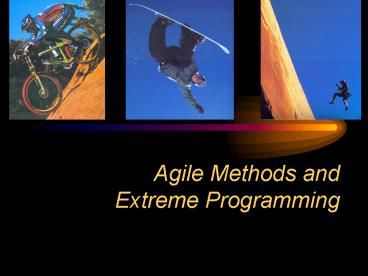Agile Methods and Extreme Programming - PowerPoint PPT Presentation
1 / 23
Title:
Agile Methods and Extreme Programming
Description:
'Driving is not about getting the car going in the right direction. ... Collective ownership. Continuous integration. 40-hour week ... 8. Collective Ownership ... – PowerPoint PPT presentation
Number of Views:63
Avg rating:3.0/5.0
Title: Agile Methods and Extreme Programming
1
Agile Methods andExtreme Programming
2
Spectrum of Methods
Source "Get ready for agile methods, with care"
by Barry Boehm, IEEE Computer, January 2002.
3
Agile Manifesto
- We are uncovering better ways of developing
software by doing it and helping others do it.
Through this work we have come to value - Individuals and interactions over processes and
tools - Working software over comprehensive documentation
- Customer collaboration over contract negotiation
- Responding to change over following a plan
- That is, while there is value in the items on the
right, we value the items on the left more.
4
Some Agile Methods
- ASD - Adaptive Software Development
- Crystal
- FDD - Feature Driven Development
- DSDM - Dynamic Systems Development Method
- Lean Software Development
- Scrum
- XP - eXtreme Programming
5
II. Extreme Programming
6
Motivation
- Knobs on a control board
- Each knob a practice that works well
- Turn all knobs up to 10
7
Learning to Drive
- "Driving is not about getting the car going in
the right direction. - Driving is about constantly paying attention,
making a little correction this way, a little
correction that way." - -- Kent Beck, Extreme Programming Explained
8
Four Values
- Simplicity
- create the simplest thing that could work
- Communication
- face-to-face, not document-to-face
- Feedback
- lots of tests
- Aggressiveness
9
Four Basic Activities
- Coding
- cannot do without it
- Testing
- if it cannot be tested it doesn't exist
- Listening
- to those with domain knowledge
- Designing
- to keep the system from decaying
10
Twelve Practices
- Pair programming
- Collective ownership
- Continuous integration
- 40-hour week
- On-site customer
- Coding standards
- The Planning Game
- Small releases
- Metaphor
- Simple design
- Testing
- Refactoring
11
1. The Planning Game
- Business people decide
- scope
- priority
- release dates
- Technical people decide
- estimates of effort
- technical consequences
- process
- detailed scheduling
12
2. Small Releases
- Every release should be as small as possible
- Every release has to completely implement its new
features
13
Waterfall to XP Evolution
Source "Embracing change with extreme
programming" by Kent Beck,IEEE Computer, October
1999.
14
3. Metaphor
- Each XP project has its own metaphor
- naive
- system is a spreadsheet
- Metaphor replaces architecture as the view from
10,000 feet
15
4. Simple Design
- Runs all the tests
- Has no duplicated logic
- States every intention important to programmers
- Has the fewest possible classes and methods
16
5. Testing
- Any feature without an automated test does not
exist. - Programmers need confidence in correct operation
- Customers need confidence in correct operation
17
6. Refactoring
- Always ask if there is a way to make the program
simpler - When the system requires duplication of code, it
is asking for refactoring - Can always find a series of small, low-risk steps
18
7. Pair Programming
- All code written with 2 people at one machine
- Driver
- thinks about best way to implement
- Passenger
- thinks about viability of whole approach
- thinks of new tests
- thinks of simpler ways
19
8. Collective Ownership
- Anybody who sees an opportunity to add value to
any portion of the code is required to do so - Everyone knows something about everything
- Everyone feels obligated to make improvements
20
9. Continuous Integration
- Integrate and test every few hours, at least once
per day - All tests must pass
- Easy to tell who broke the code
21
10. 40-Hour Week
- People should be fresh and eager every morning
- Overtime is a symptom of a serious problem
- XP only allows one week of overtime
22
11. On-Site Customer
- Real customer will use the finished system
- Programmers need to ask questions of a real
customer - Customer can get some other work done while
sitting with programmers
23
12. Coding Standards
- Everyone edits everyone's code
- Standard should require least amount of overhead
- Standard should be adopted voluntarily by the team































